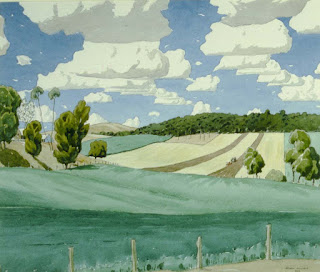Kenneth Macqueen (1897 - 1960)
By Stephen Rainbird
Kenneth Robertson Macqueen (1897-1960), artist, was born on 8 April 1897 at Ballarat East, Victoria, eldest of four children of Rev. William Sweyn Macqueen, a Presbyterian clergyman from Scotland, and his second wife Rachel Cecilia Corio, née Robertson, who was Australian born. The family moved to Brisbane in 1898 and Kenneth was sent to Bowen House School. In 1909 the Macqueens shifted to Sydney. Kenneth completed his schooling at Scots College and attended weekly drawing-classes conducted by Alfred Coffey.
In 1914 Macqueen obtained a post as a clerk at the Pyrmont works of the Colonial Sugar Refining Co. Ltd. He enlisted in the Australian Imperial Force on 3 May 1916 and served (1917-18) on the Western Front with the 12th (Army) Brigade, Australian Field Artillery. After the war he studied at the Slade School of Fine Art, University of London, and at the Westminster Technical Institute and School of Art. Returning to Australia, he was discharged from the A.I.F. on 7 November 1919. For the next three years he worked on sheep stations in New South Wales, at Trangie and Queanbeyan. In 1922 he settled at Mount Emlyn, near Millmerran, in south-eastern Queensland, where he divided his time between water-colour painting and farming.
On 2 April 1927 Macqueen married with Presbyterian forms Olive Kathleen Crane (1895-1935) in her home at Wollstonecraft, Sydney. A gifted illustrator and etcher, she supported her husband's early artistic interests. They had a daughter Marion and a son Revan. Within a few months of Revan's birth, Olive died of meningitis and her sister Mildred took over the household.
Macqueen's work first came to public attention in 1926 when it was included in the seminal exhibition, A Group of Modern Painters, held in Sydney. This showing led to the formation of the Contemporary Group, with whom he was to display his paintings throughout the 1930s. His watercolours frequently appeared in the annual exhibitions of the Society of Artists, Sydney, and had done so from the early 1920s. Having joined the Australian Watercolour Institute in 1928, he contributed to its yearly showings until the late 1950s. Macqueen held many solo exhibitions, mainly in Sydney where he was more widely known than other Queensland artists. His 'Cabbage Gums and Cypress Pines' (1940) was purchased for the Metropolitan Museum of Art, New York, in 1941, well before most Australian public galleries began collecting his watercolours. In 1953 he was awarded Queen Elizabeth II's coronation medal. He served as a trustee (1959-60) of the Queensland Art Gallery.
An unassuming and genial man with a strong affinity for the land, Macqueen was drawn to the undulating landscape of the Darling Downs and to the coastal region adjoining Moreton Bay which provided the principal subjects for his work. His watercolours are noted for their simplicity, and for their lyrical and decorative qualities. Shape, structure and colour played a dominant role in his art, engendering a bold and dynamic expression which infused vitality into the prevailing academicism of Australian water-colour painting. Macqueen's approach—which strove to reduce the landscape to a formalized, semi-abstract pattern of translucent washes—closely aligned his output with that of leading early-modernist painters. Unlike many of his contemporaries, however, he attempted to render the landscape in a more direct and expressive manner, accentuating design and rhythm as the dominant elements in his work. 'Design in landscape interests me tremendously', he wrote in his book, Adventure in Watercolour (Sydney, 1948); and he described his creative process as emanating from his response to the shapes and patterns in nature.
Macqueen preferred to work in his studio rather than in the open air. Technically he was a traditionalist, who based his approach chiefly on the early nineteenth-century British practice of water-colour painting, emphasizing the transparent-wash method and the luminosity of the paper as the distinctive qualities of the medium. His technical facility, sensibility and insight established his reputation as one of Australia's foremost water-colourists of the first half of the twentieth century.
Survived by his two children, Macqueen died of a coronary occlusion on 21 June 1960 at Millmerran and was cremated. His work is represented in the National Gallery of Australia, all State galleries, major regional and university collections, and in public galleries in New Zealand and the United States of America. In November-December 1981 a retrospective exhibition was held at the University of Queensland's art museum, Brisbane.
http://adb.anu.edu.au/






























































































































































No comments:
Post a Comment